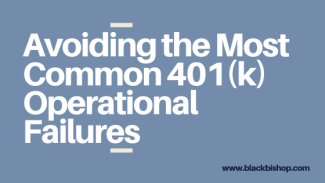
Avoiding the Most Common 401(k) Operational Failures
Avoiding the most common 401(k) operational failures is only possible if you understand what they are…
The Employee Retirement Income Security Act (or ERISA) is the law that establishes minimum standards for pension plans in private industry (including your 401(k) plan). There are three government agencies responsible for the enforcement of ERISA.
- The IRS (Internal Revenue Service) primarily looks at participation, vesting, and funding issues.
- The DOL (Department of Labor) primarily looks at fiduciary responsibility and prohibited transactions.
- The PBGC (Pension Benefit Guarantee Corporation) insures a minimum guaranteed benefit under certain pension plans.
The IRS has published a list of common 401(k) plan failures that they see during audits (that are often very costly to the plan sponsor to correct if caught during an audit). There are, however, ways to avoid these common mistakes. So, let’s take a look at what they are and what you can do to avoid them.
Common 401(k) Operational Failures
According to the IRS, here are the top ten 401(k) operational failures employers make*:
1. Failure to update your plan document within the past few years to reflect recent law changes.
To avoid this mistake, use a calendar that notes when you must complete amendments (most are due no later than the last day of the calendar year).
Review your plan document annually.
Maintain regular contact with the company that sold you the plan since they most likely know what needs updated and often will provide you with the necessary amendments.
2. Failure to base the plan operations on the terms of the plan document. (Failure to follow plan terms is a very common mistake.)
To avoid this mistake, develop a communication plan to make all relevant parties aware of changes on a timely and accurate basis (best practice).
Perform a review at least annually to ensure that you're following plan terms.
Important to note: if you create a formal Investment Policy Statement – that is now an official “plan document” and must be followed. The same is true for a Committee Charter or other legal document that provides guidance on plan operations.
3. Failure to use the plan definition of compensation correctly for all deferrals and allocations.
To avoid this mistake, perform annual reviews of compensation definitions and ensure that the person in charge of determining compensation is properly trained to understand the plan document.
4. Employer matching contributions weren't made to all appropriate employees.
To avoid this mistake, contact plan administrators to ensure that they have adequate employment and payroll records to make calculations.
5.The plan failed the 401(k) ADP and ACP nondiscrimination tests.
To avoid this common failure, consider a safe harbor or automatic enrollment plan design.
Communicate with plan administrators to ensure proper employee classification and compliance with the plan terms.
6. Eligible employees weren't given the opportunity to make an elective deferral (exclusion of eligible employees).
To avoid this mistake, monitor the census information and apply participation
requirements.
7. Elective deferrals weren't limited to the amounts under IRC Section 402(g) for the calendar year and excess deferrals weren't distributed.
To avoid this mistake, work with plan administrators to ensure that they have sufficient payroll information to verify the deferral limitations of IRC Section 402(g) were satisfied.
8. You haven't timely deposited employee elective deferrals.
To avoid this common mistake, coordinate with your payroll provider to determine the earliest date you can reasonably segregate the deferral deposits from general assets. (If this can be done the day after payroll is sent, that’s the earliest date…)
Set up procedures to ensure that you make deposits by that date.
9. Participant loans don't conform to the requirements of IRC Section 72(p) or are prohibited transactions under IRC Section 4975.
To avoid this mistake, review each participant's loan, including the loan amount, term of the loan, and repayment terms.
Ensure that there are procedures in place to prevent loans that are prohibited transactions under IRC Section 4975 or that don’t comply with IRC Section 72(p).
10. Hardship distributions weren't made properly.
To avoid this common mistake, you should be familiar with your plan document’s hardship provisions and ensure that you follow the provisions in operation.
Ensure that your plan administrators and payroll offices share the plan’s hardship distribution information.
*From the IRS 401(k) Plan Fix-It Guide
Document, Review, and Repeat
The mistakes listed above can be avoided by understanding and following the terms of the plan documents and a little proactive service provider communication and monitoring to ensure they have the right information to follow the terms as well.
If you’d like assistance in this area, we’d be happy to send you a more comprehensive guide that shows how to find the mistakes listed above, and how to fix the mistakes as well (many can be self-corrected).
With our clients, we also use a plan updates review checklist during annual reviews that we can also provide you with if interested. This checklist helps identify triggering events that might make a compliant plan move out of compliance if updates aren’t made.
Simply contact us and we’d be more than happy to send it over or discuss ways to help your plan meet the regulations.

